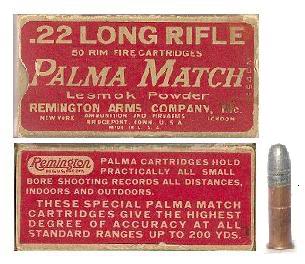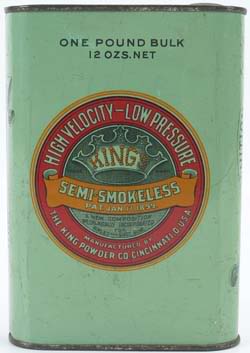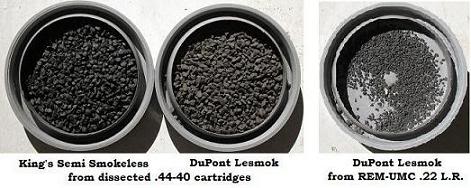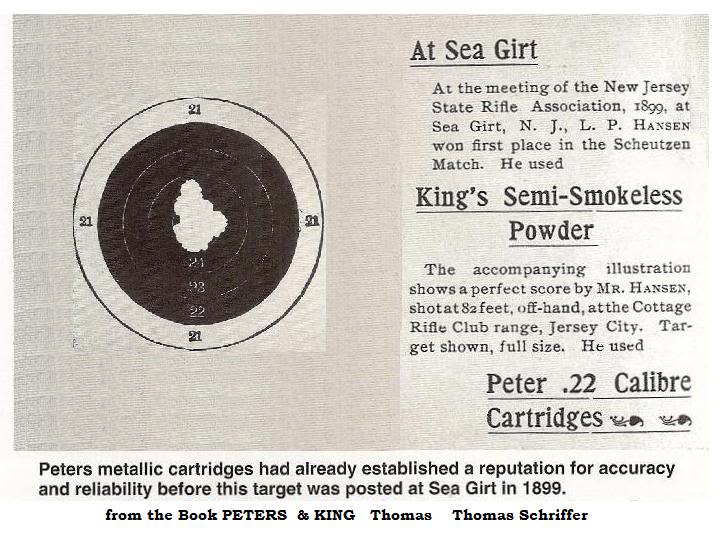Topic: Bullets From the Really 'Dark Side'
Retrieved: 12/18/2014
Last Post: 12/18/2011
The transition of powders was from original gunpowder to semi-smokeless to Cordite to nitro based powders.
Of the semi-smokeless, there were 2 powders that were developed, King's Semi- Smokeless and DuPont's Lesmok.
King's Semi-Smokeless was 1st on the market originating from their 1899 patent. DuPont, not to be left out for this powder market, developed Lesmok shortly thereafter, approximately 1890. It was made with:
* 60% potassium nitrate * 20% wood cellulose * 12% charcoal * 08% sulfur
The shooters fell in love with these accurate rounds because the foul didn't harden. But the down side was the center fire primers were corrosive!
These semi-smokeless rounds fell out of disfavor around the beginning of WWI. Best I can determine, Lesmok use waned in the 1911 to 1918 period. At least, this was the time frame that Winchester stopped selling them
Here is box of Rem-UMC 22 Long Rifle's that I found and just had to have! Needless to say, I would love to dissect and also shoot a few but then I wouldn't have a full box, would I? :'(
**** Note the cases were made from copper and have a cannelure. To me it indicates the bullets were heavier than the standard 22 rimfire with a 40 or 45gr bullet of the era
StrawHat
December 05, 2011
Always fun to get to see something from an era that has passed. Thanks for sharing the photo.
Could the cannelure have been there to keep the bullet from being pushed into the case during reloading? Normally the charge of blackpowder prevented this but with semismokeless, the volume of powder would be less.
Also, interesting to see the guarantee is written in English and Spanish. Not something I associate with the turn of that century.
w44wcf
December 05, 2011
Nice find! ;D I have the same box but it is not in as great a condition as yours. I fired several cartridges a few years ago and they went off with a "click... bang." Priming compound is almost dead...
A dissected cartridge contained a 40 gr bullet and 2.8 grs of Lesmok semi smokeless powder which was a capacity load. The cannelure serves no purpose since it is located well below the base of the bullet. Perhaps in mfg'g it was used to spin the priming compound into the rim(?)... Box color would indicate that it was made in the 1920's.

By comparison, a cartridge from a similar Peters semi smokeless box contained a 40 gr bullet over 3.2 grs of Kings semi smokeless which was a capacity load. I fired 5 of these cartridges and they averaged 1,056 f.p.s. with normal ignition.
According to the few PETERS catalogs I have, these were still listed in their 1938 catalog.
PICTURE 404
It appears that the production of semi smokeless 22 ammunition continued long after the production of other caliber semi smokeless cartridges had ceased.
Advertisement from the early 1920's...

An interesting side note: Kings Semi Smokeless could be purchased by the reloader whereas, DuPont Lesmok was not made commercially available.

Powder comparison...

John Boy
December 05, 2011
John, you totally amazed me with what you have in computer. Wanna swap hard drives?
Quote
It appears that the production of semi smokeless 22 ammunition continued
long after the production of other caliber semi smokeless cartridges had
ceased
And thanks for the PM noting the later dates that semi smokeless was on the market. I did my fact finding using Google ... would be appreciative if you would post your knowledge.
When you told me the rounds were available way past the 1918 date, I got curious. The lot number on my box is... VE?Z 39 39. Makes me wonder if the box is not vintage 1939. Believe I'll send Remington an email to try and determine the coding for this box. I did the same for a full brick of Lapua Match 22's. They responded the lot was 1972. They too are copper cases.
Check these out about Arthur Hubalek on the UMC 1920 ad... SL6303023.pdf LINK 404
Arthur Hubalek, who made 2484 in Zettler's Gallery, New York, which still stands as the 75-footofthand world's record in 100 shots. SL5022014.pdf LINK 404
w44wcf
December 09, 2011
I'm thinking that since your box (nor mine) does not say "Kleanbore" (1925>) it just might be from the early 1920's.
I did a little further investigating.
1930's - early to mid - Kings Semi Smokeless was last produced. Inventories were used up as time went by.
1934 - Remington purchased Peters. Remington owned DuPont who produced "Lesmok".
1940 - Peters catalog indicates Lesmok or Kings Semi Smokeless were loaded interchangeably. above info from the book PETERS & KING by Thomas Schiffer
1941 - Winchester catalog shows EZXS .22 "Lesmok" under target cartridges
1945 - Shooters Bible no longer shows any .22 Semi Smokeless so it was likely discontinued in the early 1940's.
From 1899

John Boy
December 09, 2011
John, thanks for the effort and time to try and date this box. I still believe that the only way to pin point the year of this box is the lot number on it ... VE?Z 39 39. If this coding follows the same pattern as other ammo & powder I've hunted down, the VE?Z 39 39 could possibly be the 3rd of September, 1939. It fits within the later time era of semi smokeless
re: King's Semi Smokeless
And a real big thanks for the Sea Girt jpg. I have not been able to identify that 22 matches were held at Sea Girt, including copies of NJ Adj General reports in the 1890's that the Asst Curator of the Sea Girt Museum gave me. Because these Palma Matches were conducted primarily as military matches, not civilian.
And this shooter Hanson, must have been a specialized 22 shooter. Never heard him mentioned with other match references I've come upon. But for 22 matches, several mentions of his perfect score and this is the first picture of it that I've seen. The other readings don't have the target as part of the text
John Boy
December 12, 2011
UREKA - Found out when these Lesmok Palma Match 22 LR rounds were made
Called Remington Customer Service. The nice lady on the phone has old catalogs and product listings that go back to 1935. Gave her the lot number and she came up blank. She asked was there was any other coding on the box?
"Yes. Ma'am! It is R54PM on the right side of the face of the box." Within seconds she says... 1939 - 22 Long Rifle, Palma Match - Lesmok with a cost of $9.06 for 1000 rounds!
John Boy
December 12, 2011
Remember the nice lady told me that a 1000 Palma Match Lesmoks cost $9.06 in 1939? Ok, hang onto your chair:
$9.06 Cost of Inflation indexed from 1939 to 2011 = $147.58
Today's Prices for example -Remington/Ely Club Xtra .22 caliber ammunition is competition-grade ammunition designed by Eley:
$16.99 for a box of 50 x 20 boxes (1000 rounds) = $339.80!
A whopping 200.30% greater that the indexed Inflation Rate. Who said 22 RFs are cheap!
w44wcf
December 17, 2011
Thank you for the update. I still wonder though about "Kleanbore" not being on the box as it was on other Remington 22 boxes after 1925...
As an aside note I recently scored a 19 pc lot of 45-70 Peters Cartridges (no box). Since there was no cannelure, I thought "Kings Semi Smokeless."
A dissected cartridge contained semi smokeless alright but it was Lesmok, not Kings. That fell right in line with the comment in the Peters 1940 catalog regarding Kings or Lesmok being used interchangeably.
John Boy
December 18, 2011
John, look what I found...

R13. Remington 22 Long Rifle PALMA Hi-Speed. Product code is 54PB. Box is 1926 issue. Slight shelf wear on the top. $45.00
http://www.ammolady.com/id7.html
Look at the whole site - some nice stuff... www.ammolady.com
And sometimes one can't believe all that is printed - Phil Sharpe's book said that post WWII was when Remington started using non mercuric primers